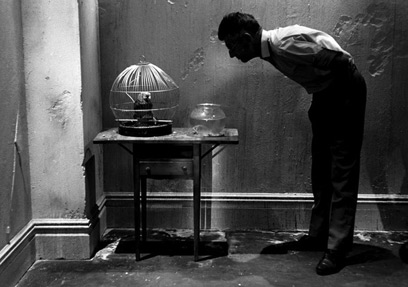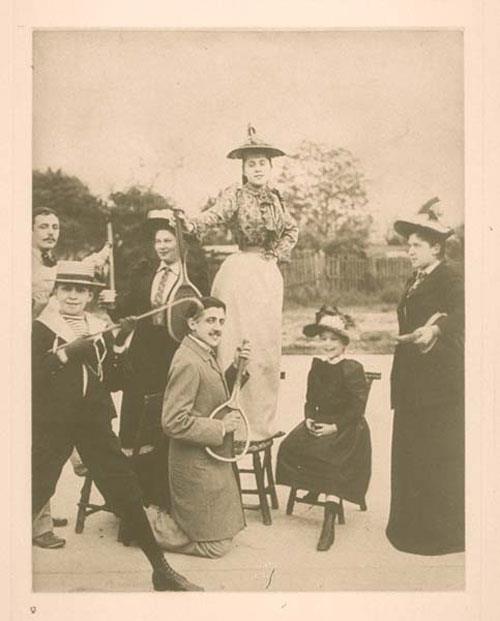ideas

There are several trends that might suggest a diminishing role for mathematics in engineering work. First, there is the rise of software engineering as a separate discipline. It just doesn’t take as much math to write an operating system as it does to design a printed circuit board. Programming is rigidly structured and, at the same time, an evolving art form—neither of which is especially amenable to mathematical analysis.
{ IEEE | Continue reading }
photo { Guillaume Zuili }
ideas, mathematics | May 22nd, 2012 12:15 pm

Multiple Maniacs is a 1970 comedy film by American filmmaker John Waters. […]
Plot:
Lady Divine is the owner and operator of a show called The Cavalcade of Perversion, a free exhibit of various perversions and fetish acts and obscenities such as the “Puke Eater.” The show is free, although the various performers must persuade and even physically drag reluctant passers-by to attend.
As a finale to every show, Lady Divine comes in and robs the patrons at gunpoint. This arrangement seems successful to Lady Divine’s lover, Mr. David, until Lady Divine becomes bored with the routine, and decides to murder the patrons rather than merely robbing them.
{ Wikipedia | Continue reading }
ideas, showbiz | May 21st, 2012 11:51 am

Ancient philosophy - especially after Aristotle - largely focused on how to achieve self-sufficiency on the one hand, and peace of mind on the other; it thus became fundamentally therapeutic, in nature and goal. Though ancient philosophers are generally known for their praise of friendship, there is an evident tension involved in these positions: the possession of friends seems almost unhelpful, nearly inimical, to self-sufficiency and peace of mind. As fulfilling as friendships generally are, they often lead to mutual dependency and a loss of the tranquility thought to accompany solitude. The problems grow even more acute when one considers other, more intimate forms of human relationships, those celebrated less widely in ancient philosophy, such as sexual intercourse and romantic love, both of which intuitively seem even more threatening to self-sufficiency and mental tranquility than friendship does. Two schools of Hellenistic philosophy in particular, Stoicism and Epicureanism, struggled to find coherent positions on each of these three forms of human relationships, to draw clean lines around what is worth pursuing and what is not, what is acceptable and what is not; ultimately, both schools generally agree that those relationships based on natural feelings are healthy and should be fostered, and those which degenerate into reasonless passion or emotional dependency should be avoided.
{ The Montréal Review | Continue reading }
screenshot { Gary Cooper and Ann Harding in Henry Hathaway’s Peter Ibbetson, 1935 }
ideas, relationships | May 17th, 2012 1:48 pm

Women are picky. The general idea is that females invest more in reproduction, and, as such, need to be more selective about their partners. This purportedly has its root in anisogamy, a complicated word to say that egg cells are more expensive to produce, and lesser in number, than sperm cells. Basically, females have to use their egg cells carefully, while men can go around and generously spread their sperm. […]
Two main suggestions:
• Sexy sons: choosy females pick sexy males to mate with. Their offspring inherits both the preference and the attractiveness. And a positive feedback loop follows.
• Good genes: male attractiveness signals additional quality, or more precisely breeding value for fitness. The sons of attractive males inherit these qualities along with the ‘being sexy.’ Here, there is a link between attractiveness and ‘quality.’
{ The Beast, the bard and the bot | Continue reading }
images { 1. Phillip Pearstein | 2 }
relationships, science, theory | May 16th, 2012 12:14 pm

Thinking about eternity is not simply an esoteric mental exercise. It’s a cure for boredom. […]
Witness the man of stone. It takes an eternity for his eyes to blink even once. He stares at the sun, the moon, and the stars as they pass by turns overhead. One day he crumbles and only a pile of rubble remains. He wasn’t cut out for the eternal.
{ The Science Creative Quarterly | Continue reading }
photos { Nadav Kader }
ideas, photogs, time | May 15th, 2012 2:48 pm

Photographers: you’re being replaced by software
For the first time in history, photography is about to lose control of its monopoly on affordable, convincing realism and it’s time for us to understand that realism has never been the most important feature of the photograph.
{ Photo Journal | Continue reading }
ideas, photogs, technology | May 15th, 2012 12:05 pm
Proust, flashback, photogs | May 15th, 2012 12:02 pm

The great innovations come with side-effects. I have encountered people who said this about our chronic back pains being a side-effect of upright walking. It is a great thing but may have a couple of weak spots. We would actually be surprised if evolution didn’t take some time in a shake down of a new species.
A recent paper in Cell by 20 authors has tackled the question of whether autism is the unfortunate result of the malfunctioning of a relatively new aspect of the human brain.
{ Thoughts on thoughts | Continue reading }
painting { Francis Bacon, Portrait of Michel Leiris, 1976 }
Francis Bacon, brain, theory | May 15th, 2012 5:39 am

Since its publication (1859), the evolution theory of Charles Darwin has met with considerable opposition, notably from religious circles. Although scientific opposition decreased soon after, public rejection of evolution never died down. Recent research shows that a substantial part of the western world does not accept the idea of evolution. This article tries to understand the evolution controversy by reframing it as a phenomenon of public understanding of science.
Findings suggest that the decision to reject evolution does not involve scientific knowledge. Arguments drawn from science are merely viewed as an addition to a decision that is already made and serve as a rationale to a non-rational decision.
{ SAGE | Continue reading }
image { Karin }
ideas, science | May 13th, 2012 3:55 pm

The parent-offspring conflict theory delineates a zone of conflict between the mother and her offspring over weaning. We expect that the mother would try to wean her offspring off a little earlier than the offspring would be ready to wean themselves, thereby entering the zone of conflict for a short span of time. Though the theory was originally formulated in the context of weaning, it is also relevant in other contexts where a parent and his/her offspring have conflicting interests. Conflict has been reported over feeding, grooming, traveling, evening nesting, and mating in various species.
There are several theoretical models that address parent-offspring conflict in different contexts like reproduction, intra-brood competition, sexual conflict, and parental favoritism toward particular offspring. Though relatedness between parents, offspring and siblings can be measured easily, it is not easy to measure precisely parental investment and the costs and benefits to the concerned parties in nature. In some studies attempts have been made to quantify parental care in terms of milk ingested by offspring, sometimes as a correlate of weight gain by the individual pups, and sometimes by the duration of suckling. However, we have to accept that there is considerable variation in the suckling rates of individual pups, and in hunger levels of individuals, and hence such measures can only provide a rough estimate of parental investment. It is therefore not surprising that empirical tests of the theory in a field set up are sparse, especially in the original context of weaning. The parent-offspring conflict theory has in fact been claimed to be one of the most contentious subjects in behavioral and evolutionary ecology and also one of the most recalcitrant to experimental investigation.
{ arXiv | PDF }
animals, science, theory | May 13th, 2012 3:55 pm

A new study suggests that, by disrupting your body’s normal rhythms, your alarm clock could be making you overweight.
The study concerns a phenomenon called “social jetlag.” That’s the extent to which our natural sleep patterns are out of synch with our school or work schedules. Take the weekends: many of us wake up hours later than we do during the week, only to resume our early schedules come Monday morning. It’s enough to make your body feel like it’s spending the weekend in one time zone and the week in another. […]
Previous work with such data has already yielded some clues. “We have shown that if you live against your body clock, you’re more likely to smoke, to drink alcohol, and drink far more coffee,” says Roenneberg. […]
The researchers also found that people of all ages awoke and went to bed an average of 20 minutes later between 2002 and 2010. Work and school times have remained the same, meaning that social jetlag has increased during this period.
{ Science | Continue reading }
photo { Weegee in his apartment, police radio by his bedside }
health, science, sleep, time | May 11th, 2012 1:58 pm

The hypothesis was that people who used particular basic word orders would have more children. Testing this hypothesis directly, basic word order is a significant predictor of the number of children a person has (linear regression, controlling for age, sex, if the person was married, if they were employed their level of education and religion, t-value for basic word order = -18.179, p < 0.00001, model predicts 36% of the variance).
It turns out that speakers of SOV languages have more children than speakers of SVO languages, while speakers with no dominant order have the fewest children on average.
{ Replicated Typo | Continue reading }
photo { Michal Pudelka }
Linguistics, kids | May 11th, 2012 1:47 pm

Small children (age 4-6) who were exposed to a large number of children’s books and films had a significantly stronger ability to read the mental and emotional states of other people. … The more absorbed subjects were in the story, the more empathy they felt, and the more empathy they felt, the more likely the subjects were to help when the experimenter “accidentally” dropped a handful of pens… Reading narrative fiction … fosters empathic growth and prosocial behavior. […]
Psychologists have found that people who watch less TV are actually more accurate judges of life’s risks and rewards than those who subject themselves to the tales of crime, tragedy, and death that appear night after night on the ten o’clock news. That’s because these people are less likely to see sensationalized or one-sided sources of information, and thus see reality more clearly.
{ OvercomingBias | Continue reading }
image { Gary Stephen Brotmeyer }
books, ideas, media, psychology | May 11th, 2012 12:06 pm

I’m what they call a media ecologist, so I believe in media environments — both explicit ones and implicit ones. So it’s like the lightbulb is a media environment, right? You turn on the lightbulb, and you have a different environment because of that medium. But print is a media environment that encourages certain ways of looking at the world. Television changes us. Internet is a media environment. Somehow our media environment, combined with our economic environment, can really amplify one another’s effects in dangerous ways.
Way back in the mid-1990s — when Wired announced that we’re living in an attention economy, when everyone came up with these metrics to measure eyeball hours and the “stickiness” of websites — there was this competition to get our attention. Parallel to that is the sudden emergence of all these attention disorders and new prescriptions for Ritalin. So I’m thinking, we’re living in an attention economy, in which it’s been declared by Wall Street that the one commodity we’ve got to extend in order to make more money is human attention. And then we start drugging our children to pay more attention. I can’t help but worry. Not that there’s a specific conspiracy — Oh, let’s drug the children so they pay more attention — but rather, we’re living in a world where the brunt of our technological know-how is being spent on maintaining attention. Kids start to show these defense mechanisms against paying attention.
{ Douglas Rushkoff interviewed by Samantha Hinds | Continue reading }
photo { Christian Patterson }
ideas | May 9th, 2012 3:51 pm

Modernity became obsessed with analysis and the elimination of vague, ambiguous, or contradictory ideas. We fell almost completely under its sway and came to imagine that the picture of reality that such thinking provided gave us the best way to understand our world and our place in it.
It was as if we had finally found our way out of the cave and into the kind of light that Plato had thought existed with the Platonic forms. It appeared that modern thinkers had found their way out of the shadowy and mysterious realm of our actual experience and found the kind of certainty that Plato had sought.
Today, however, we are able to see that from a very different perspective because of what we know concerning the human brain. We now know that as appealing as such certainty is, it merely represents one way that the human brain is capable of thinking. Instead of the moving picture of our actual experience, we are capable of ideas that represent snap shots, which make the distances, perspectives, and relations that we actually experience appear fixed and give us the kind of clear and distinct ideas that we crave.
In the seventh book of the Republic, Plato sets forth his famous allegory of the cave. The traditional understanding interpreted it as Plato arguing that both becoming and being were real because there were two different worlds or realms of reality. One was the world of sense-data, which the Pre-Socratic philosopher, Heraclitus argued was purely a matter of becoming. In this world, nothing ever exists in a pure state of being but is always becoming something else.
Plato however, claimed that there was another world where things did exist in a pure state of being. Parmenides and several other Pre-Socratic philosophers had long claimed that the world of which Heraclitus spoke was an illusory world produced by a naïve trust in our unreliable senses and that in fact reason showed us that only being truly existed and all becoming and change was illusory. Plato agreed with both Heraclitus and Parmenides: he believed that the world of our sense data was real and not merely illusory, but there was also a world of pure being - the parallel universe that Plato would come to describe as the world of the forms.
{ The Philosopher | Continue reading }
photo { Steve Schapiro, Samuel Beckett Looking at Parrot, New York, 1964 }
brain, ideas | May 9th, 2012 7:32 am

Team-building exercises, simulation games, educational games, puzzle-solving activities, office parties, themed dress-down days, and colorful, aesthetically-stimulating workplaces are notable examples of this trend. […]
This is a relatively new conception of the relation between work and play. Until very recently, play was seen as the antithesis of work (see Kavanagh, this issue). Classical industrial theory, for example, hinges on a fundamental distinction between waged labour and recreation. Play at work is thought to pose a threat not only to labour discipline, but also to the very basis of the wage bargain: In exchange for a day’s pay, workers are expected to leave their pleasures at home. […]
When employees are urged to reach out to their ‘inner child,’ it becomes clear that the distinction between work and play is increasingly difficult to maintain in practice.
With such blurring of work and play, the traditional boundary between economic and artistic production also disappears. In much of the business literature on play, the entrepreneur and the artist melt into one figure. […]
Yet while contemporary organizations have colonized play for profit-seeking purposes, this inevitably has unforeseen consequences. Play may turn back against the organization and disrupt its smooth functioning; the managers who open a game in the organization may find that they lose control over it and come to realize that play is occasionally able to usurp work rather than stimulate it. Play serves organizational objectives only insofar as it is kept within certain ludic limits. […]
This special issue emerged from an ephemera conference on ‘Work, Play and Boredom’ held at the University of St Andrews in May 2010. At the heart of the conference was the idea that ‘boredom’ might be an appropriate concept for rethinking the interconnections between work and play in present-day organizations.
{ ephemera | PDF }
photo { Lee Friedlander, New York City, 1962 }
economics, ideas, leisure | May 8th, 2012 10:54 am

If we look at how communication works we find that words and phrases have a great influence on attention. They bring into the consciousness of the listener the concepts that are uttered. This is what meaning is – the concepts that a word or phrase can steer attention towards. This is what communication is – the sharing of attention by two (or more) brains on a sequence of concepts.
So it is not surprising that it is useful to talk to oneself. What we are doing when we self-talk is to steer our consciousness. In recent paper, Lupyan and Swingley look at how self-directed speech affects searching.
{ Thoughts on thoughts | Continue reading }
Linguistics, psychology | May 8th, 2012 10:54 am

When you “lose yourself” inside the world of a fictional character while reading a story, you may actually end up changing your own behavior and thoughts to match that of the character, a new study suggests.
Researchers at Ohio State University examined what happened to people who, while reading a fictional story, found themselves feeling the emotions, thoughts, beliefs and internal responses of one of the characters as if they were their own - a phenomenon the researchers call “experience-taking.”
They found that, in the right situations, experience-taking may lead to real changes, if only temporary, in the lives of readers.
{ Ohio State University | Continue reading }
photo { Joel Sternfeld }
books, psychology | May 7th, 2012 1:44 pm

Are straight people born that way? (…) We have to start with a more fundamental question: What do we mean when we say someone is “straight”? At the most basic level, we seem to be imagining female bodies that are specifically sexually aroused by male bodies, and vice versa.
Laboratory studies (…) suggest that, while such people probably do exist — at least in North America, where many sexologists have focused their attentions – it’s not uncommon for straight-identified people to be at least a little aroused by the idea of same-sex relations.
The media has tended to broadcast the news that gay-identified men and straight-identified men have quite discernible arousal patterns when they are shown various kinds of sexual stimuli. And that’s true. But if you look closely at the data, you’ll see that most straight-identified men do tend to show a little bit of arousal across sex categories (as do gay-identified men).
{ The Atlantic | Continue reading }
painting { Ingres, Madame Moitessier, 1856 }
ideas, relationships, science, sex-oriented | May 3rd, 2012 12:41 pm

It is possible to have Hunger-Games-like situations where everyone strongly expects everyone to fight until only one is left standing. And yes, in such situations you are better off hitting first, before they can hit you. But the first question you should always ask is, just how sure are you that you are in fact in such a situation.
This is what I think every time I hear people talk about inevitable future conflicts, be they Earth v. alien, robots v. humans, human v. animal, west v. east, rich v. poor, liberal v. conservative, religious vs. athiest, smart v. dumb, etc. Yes, if enough folks will see this as unrestrained war to the death, then you should consider striking first. And yes, there probably will be some sort of war eventually. But if you are wrong about the war being likely soon, you could cause vast needless destruction.
{ Overcomingbias | Continue reading }
photo { Facundo Pires }
ideas | May 3rd, 2012 12:41 pm






















